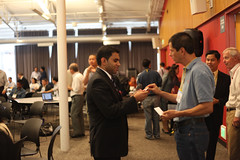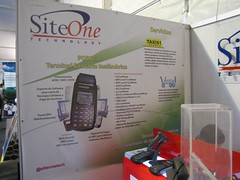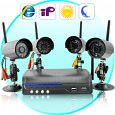The hot new craze in Internet access is Wi-Fi and its soon-to-be big brother Wi-Max. Wi-Fi is a wireless connection that allows users to access the Internet without the computer being connected to a cable. And yes, it's very convenient. Imagine walking from the sofa to the bedroom with your laptop and never loosing your connection. Imagine the freedom and flexibility afforded schools and office workers. No more ugly bothersome cables to tie you down. You're free to roam the Internet with your fingers while roaming your home, school or office with your feet. Freedom to move and freedom to surf. Perfect for the individual who is on the go and up to date with the latest technology. You can even have free Internet access at your local coffee shop. Same for airports. What a great idea. Or is it?
What exactly is Wi-Fi? Wi-Fi is a common term that stands for 'wireless fidelity.' It simply means that a computer can access the Internet without wires or Cables. In other words, he manages to have a wireless connection to the Internet. It 's like a base station and place it in your area home, classroom or office. Wi-Fi is basically the same type of connection, as used to operate a mobile phone. This is a product of convenience, since you can access the Internet with a desktop computer or laptop, without the need for connecting cables. The move from room to room with a laptop and no cable is anice convenience although it certainly isn't a necessity.
Antenna Booster Wireless

How does Wi-Fi work? Wi-Fi is really very similar to your cell phone. Radio signals are transmitted from the computer or Bluetooth device to a wireless router, sometimes called a wireless access point (WAP) or wireless local area network (WLAN). The router then sends the signal to the Internet through a cable modem. So this router or wireless access point is really the device responsible for transmitting the harmful radio waves. Any number of computers or devices can be configured to connect to one wireless router to make Internet connections. The workable distance is about a range of 300 feet or more from the wireless access point while most distances for good connections are maintained at about 100 feet. And, of course there are many variables that can affect this connection. Laptop computers and Personal Digital Assistants (PDAs) are the most common devices utilizing Wi-Fi technology.
Wi-Fi Emits Radio Frequencies Wireless connections emit radio frequency signals, or radiation, just like cell phones, cell phone towers and other wireless devices. Wi-Fi usually transmits its signal at frequencies in the range of 2.4GHz to 5 GHz. Cordless phones often transmit in the 2.4GHz to 5 GHz range, too, and this often causes the cordless phone to interfere with a wireless internet connection to a nearby computer. The Wi-Fi frequency is considerably higher than the frequencies used for cell phones which operate in the 850 MHz to1900 MHz range. This higher frequency allows more data to be carried. However, as we'll see later, it is not the frequency of the signal that does the damage to our health. So the higher Wi-Fi frequency isn't really the issue at all when it comes to health considerations.
Wi-Fi Hotspots Now In Schools Wi-Fi has become popular in the home, office, the airport and coffee shops. Many cities are now installing "hot spots" where one can take a laptop computer and freely access the Internet over the provided network. This is what is known as a "hot spot." It's a place to make a wireless connection to the Internet. And they are springing up everywhere. Entire cities are becoming wireless allowing one to connect to the Internet from anywhere in the city. And due to the ease of convenience Wi-Fi connections in schools are now becoming quite popular, too. No longer are computers hard-wired to a connection in a classroom. Connections are now virtual and allow the user, student or teacher, the freedom to connect anywhere in the school without the burden of being restricted by cable connections.
Why Wireless Connections Are Harmful There are two potentially harmful mechanisms in which Wi-Fi users, including school children, may be harmed. The first mechanism involves the exposure to radiation from the distance or proximity of the user to the computer monitor. This form of exposure originates from the electromagnetic field being given off by the monitor itself and has nothing to do with the wireless connection. Electromagnetic radiation is given off by the computer screen regardless of whether the connection is wired or wireless. Any and all computer screens produce electromagnetic radiation. These electromagnetic fields can be substantial in strength and can reach levels much higher than the 1 milligauss (1 mG) threshold level of exposure recommended by experts as being safe. Such a field can easily be measured with an inexpensive instrument called a gauss meter.
The second mechanism of harm comes from the radiation or radio wave itself. The wireless signal, oscillating at 2.4 to 5 GHz, moves much too fast for the body to recognize. So this wave isn't doing the damage. However, anytime any data or information is transmitted, say through our voice, through text messages or through the sending of information, the data is packaged and "piggy-backed" onto the first wave. This creates a second carrier wave and this wave is called the information-carrying radio wave, or ICRW. It is the information-carrying radio wave that is producing the harm. Here's how this happens. This second carrier wave, or ICRW, oscillates in a much lower Hertz (Hz) range that is easily recognized by the body. When the ICRW comes in contact with the body the body recognizes this wave and responds to it as if this carrier wave were some type of foreign invader. When this happens certain physiologic changes occur which are very significant. First, at the cellular level, the cell membrane changes and becomes less permeable. This occurs because the active transport channels shut down as the cell goes into a protection mode. This loss of permeability means nutrients can't get inside the cell where they are needed. In other words, the cell doesn't get nourished.
Conversely, since the cell membrane is now less permeable, the toxins and free radicals that build up inside the cell as a natural part of our daily metabolism can't get out. The buildup of toxins and free radicals inside the cell causes other problems. These toxic products damage the mitochondria inside the cell. If you'll remember from biology class the mitochondria are where energy for the body is produced. When this energy-producing process is damaged the cell begins to lose its ability to function.
In addition, cells lose their ability to communicate with one another. When one cell can't communicate with another cell and messages don't get sent or received the body can't respond properly to any type of stress, injury, or invasion. Furthermore, the DNA inside the cell becomes damaged. Fragments of DNA break off and form something called micronuclei. Micronuclei are precursors to cancer formation. And when enough energy is lost and when enough malnourishment occurs the cell eventually becomes dysfunctional and dies. When enough cells die the tissues are affected. When enough tissue is affected organs become damaged and don't work properly. And the cascade of damaging events begin that can lead to a multitude of symptoms and failure of the body's defense mechanisms to act appropriately.
The Wi-Fi Problem Think of Wi-Fi this way. It's really nothing more than a small version of a cell phone tower placed in the classroom or office. Or, it could be similar to having a cordless phone in your home with multiple handsets throughout the house. The base station is the access point and all the peripheral phones connect with it wirelessly. The radio frequency radiation being emitted is the same. The information-carrying radio wave is being transmitted continuously 24 hours a day. The connections from the computers and other wireless devices throughout the school, office or home to the wireless access points cause any user around them, (children, teacher, staff, etc.) to be continuously exposed. Everyone in the building is caught in the crossfire of the continual access to the wireless access points. Even non-users are exposed because of the blanketing effect of these wireless access points throughout the building. So no one escapes the exposure.
In understanding the danger of Wi-Fi we must remember that it is not the type of device, in this case a wireless access point or router that is important. Rather it is the type of radio frequency radio waves that are being produced by the device that are significant. Whether from a wireless router, a cell phone, a cell phone tower, or personal digital assistant (PDA), electromagnetic frequencies are produced by all these devices. We must look at the technology being used by these devices and not the device itself as the problem. This should be the primary concern as we evaluate their safety, particularly in the classroom.
Another important aspect of Wi-Fi exposure is that of modulation. Modulation refers to whether or not the signal frequency is constant or pulsed. The new digital cell phones operate on a pulsed frequency, as does all wireless technology. Studies have shown that these pulsed signals are a greater risk than analog, non-pulsed signals. 1
Certainly, by the addition of any type of wireless we are adding to the burden of electropollution we are all currently exposed to. Special consideration should be given to the additional exposure that Wi-Fi technology would bring to those in a classroom, including the instructors, teachers, staff and certainly students.
Children Are More Vulnerable Concern about the increased vulnerability to electropollution by children has valid reasoning. Since the skull bones of the head don't fully harden until about age 22 the skull bones of a child's head are softer than that of an adult. A softer head bone translates to easier penetration through the skull and into the head by radio frequency radiation. Furthermore, the head of a child contains more water since the brain is not fully developed. It would make sense then that water will act as a conductor to electromagnetic radiation increasing the possibility of even further damage. And since a child's brain and nervous system is still developing it only stands to reason that the potential damage would be greater since cells that are in a growing phase are more easily damaged.
And finally, exposing children in the elementary schoolroom will add to both the amount of electromagnetic radiation exposure and the accumulated length of exposure over their lifetime that they will be exposed. No one can argue that the children of today's generation will be exposed to far greater amounts of electromagnetic radiation and will be exposed to it for a much longer period of time than any generation before. We simply don't know the consequences of this increased and cumulative exposure. And it's an experiment that we shouldn't place our children in. Why set up these networks without understanding any of the long-term consequences? Did we not learn a lesson from the tobacco and asbestos industries?
Effects of WirelessRadio Frequency Radiation Although no studies have been done on Wi-Fi per se there is a generous amount of research that has been carried out on cell phones, cell phone towers and masts. Since the Wi-Fi signal is the same type of radiation (only the frequency is different) one can assume with reasonable assurance that the effects of exposure to Wi-Fi will follow the same pattern of exposure to cell phones and cell phone towers.
Here's an example of what can happen. Let's say one works in a schoolroom or office where wireless access, or Wi-Fi, is used. In other words, we are continually exposed to a constant bombardment of electromagnetic radiation waves. Over time, sitting or working in this classroom or office, the cells of the body gradually loose their energy and consequently their ability to communicate. What if the function of a particular group of cells was to maintain the integrity of the blood-brain barrier? The blood-brain barrier is an intricate membrane that keeps harmful substances and toxins from contacting sensitive brain tissue. But what if the cells of the blood-brain barrier can't communicate or don't work any longer? The barrier would break down and this would allow harmful substances to enter. Those substances would then come in contact with sensitive brain cells. The result would be injured and damaged brain cells. This is just one example of how a particular group of cells can be adversely affected by electromagnetic radiation. In fact, studies have shown that placing a call on cell phone for just two minutes can disable the blood-brain barrier. 2 The same case could be made for the immune system and any other major "system" of the body since different cellular groups perform different functions to keep us healthy.
There are more than a dozen studies linking an increased risk for brain cancer and acoustic neuroma (tumor of the auditory nerve) to radio frequency radiation from cell phones and cordless phones. 3
Even the World Health Organization (WHO) is concerned about the effects of radiofrequency radiation on children's health. In a recent WHO publication they wrote:
"The possible adverse health effects in children associated with radiofrequency fields have not been fully investigated."
"Because there are suggestions that RF(radio frequency) exposure may be more hazardous for the fetus and child due to their greater susceptibility, prudent avoidance is one approach to keeping children's exposure as low as possible."
"Further research is needed to clarify the potential risks of ELF-EMF and radiofrequency fields for children's health."
Neurobehavioral effects of inhabitants living near a cell phone tower base station have also been studied. The following neuropsychiatric complaints were reported: headache (23.5%), memory changes (28.2%), dizziness (18.8%), tremors (9.4%), depressive symptoms (21.7%), and sleep disturbances (23.5%). 4 In addition, tests of attention and short-term auditory memory were significantly lower in the exposed participants than in control groups.
Obviously, people living close to cell phone towers have an increased risk for developing neurobehavioral problems.
Will We Medicate Our Children Unnecessarily? If indeed neurobehavioral symptoms are produced by radio frequency radiation and these frequencies are continually emitted throughout our schools what might this suggest about the abnormal behavior of students in the classroom? Might parents be inclined and persuaded to medicate their children so that these undesirable symptoms can be controlled? If so, how many of these children would be medicated unnecessarily? Studies now show that the frequencies such as that emitted by cell phones cause abnormal brain hyperactivity. Such artificially induced hyperactivity would cause an unnecessary risk and expense to students who would be placed on some form of pharmaceutical intervention to aid in controlling these symptoms. Many of the drugs used in controlling hyperactivity, such as Ritalin, Concerta, and methylphenidate are in the amphetamine-like class of pharmaceuticals. What a tragedy it would be to find out years later that this form of medication was unnecessary and could have been avoided if we would have chosen precaution over convenience.
Learning Issues As discussed earlier, the mechanism of harm caused by electromagnetic frequencies occurs at the cellular level. The eventual outcome of this harm is disruption of cell-to-cell communication. When the disruption of cell communication occurs cells can't "talk" to each other. When cells can't communicate cognition is affected, the ability to learn is affected, the ability to retain information is affected, and behavioral problems can occur.
Makes Kids Susceptible To Other Stressors Radiofrequency radiation is also a stressor to the body. The mere fact that the cells of the body react to these frequencies as discussed earlier indicates that they are harmful. When the stress response occurs from exposure to electromagnetic frequencies the body responds by releasing stress proteins, also known as heat shock proteins, to minimize the ensuing damage. The release of heat shock proteins is just one stress response mechanism that has been identified. Other mechanisms include the triggering of adrenal hormones like adrenaline. Continual stress is not healthy as it can eventually fatigue the adrenal gland, suppress the immune system, and lead to fatigue causing difficulty in concentration. Sleep disturbances may also occur.
Immune System Affected Evidence also exists that radio frequencies produced by such devices as cell phones, Wi-Fi, computers, televisions, etc. can trigger skin reactions.5 Microwave frequencies can trigger the release of chemicals from mast cells. Mast cells in the skin will break open and release chemicals that cause the symptoms of allergic skin reactions. 6 One of the chemicals released by mast cells is histamine. Histamine is often responsible for the symptoms of allergies such as runny nose, watery eyes, inflammation and difficulty breathing. Histamine also constricts the airway leading to or worsening the symptoms of asthma. It is of interest to note that the rate of asthma in children has doubled since 1980 and asthma now affects one in 10 children. The cell phone was introduced in1983 and has seen explosive growth in use in the last decade. Could there be a correlation between the rising rates of asthma, an immune system problem, and the escalating use of cell phones and wireless technology? Certainly, one could anticipate that chronic exposure to these radio waves over time can lead to chronic inflammatory responses.
Electromagnetic Radiation Connected To Autism A recent study has now suggested a direct link between autism and electromagnetic radiation. It appears that EMR may accelerate autistic spectrum disorders. 7 It is noteworthy that the increasing rates of autism parallel the growth of the cell phone and wireless industry. This appears to occur as a result of the trapping of heavy metals within the cell and the inability of the body to excrete the toxic metals present that are often introduced into the body through vaccinations. Heavy metals are neurotoxic. When this excretory process is prohibited these heavy metals, such as mercury, lead, beryllium, and aluminum, damage nerve structures and interfere in inter-cellular communication. This leads to neurological problems and conditions like those found in autism spectrum disorders. This particular study has shown that when electromagnetic radiation is largely eliminated the efficiency of heavy metal detoxification and removal was dramatically increased. In other words, the body was able to excrete and eliminate heavy metals when it had not been able to do so previously. This leads to the suggestion that (1) we need to reduce or eliminate electromagnetic radiation from any child's environment and (2) measures need to be taken to repair the damage that has already been done by electromagnetic radiation. Although this study looked specifically at autism the same case could be made for attention-deficit disorders and related conditions.
Occupational Hazard For Teachers And School Staff Children will attend school in a particular building for a finite number of years and then move on. For a child the length of time spent in a particular building or location is predetermined. Therefore their exposure levels to this form of radiation will probably change. But what about the teachers and staff members who continue to work in the same building for many, many years? For these workers and teachers the exposure in their building from Wi-Fi networks and radio frequency radiation is continual. What are the effects of this exposure after years and years of time? Will teaching in a Wi-Fi enabled school become an occupational hazard like that of an electrician? These are questions that must and should be answered before, rather than after, any installation of radiation-generating equipment is placed in service.
Wi-Fi In European Schools The European Environment Agency is calling for immediate steps to be taken to reduce exposure to Wi-Fi, cell phones and cell phone towers and masts. Recent international scientific reviews have concluded that electromagnetic radiation safety limits are "thousands of times too lenient" and one official British report came to the conclusion that the development of cancer from cell phone use could not be ruled out.
Sir William Stewart, chairman of the Health Protection Agency in the UK, is calling for a formal investigation into the hazards of using wireless networks in schools. He's asking that students be monitored for health problems from the networks. Joining him in health concerns over Wi-Fi installations in schools, the Professional Association of Teachers are calling for the Secretary of State for Education in the UK to begin an official inquiry into the issue.
Recently, parents of children at an English school have won a major battle in getting a mast tower removed from their school. Parents indicated that both students and staff complained of symptoms such as insomnia, headaches and numbness. It seems 56 percent of children had trouble sleeping, 54 percent developed headaches and migraines, and 46 percent reported dizziness and numbness. 86 percent of staff members had problems sleeping, 59 percent reported headaches, and 95 percent of staff reported fatigue and numbness. Nosebleeds, nausea, and dizziness were also reported. 8
Dr. Gerd Oberfield, head of environmental health and medicine in the province of Salzburg, Austria, calls the installation of Wi-Fi "dangerous." In fact, the government in Salzburg has been advising schools not to install Wi-Fi for well over a year now and is considering a complete ban on Wi-Fi networks.
Stowe School in Great Britian recently removed its Wi-Fi equipment from its building. One of its schoolmasters who had taught there for 28 years developed headaches and nausea immediately after Wi-Fi was installed.
International Association of Fire Fighters In 2004, the International Association of Fire Fighters (IAFF) voiced its opinion on cell phone towers and antennas by opposing the installation of cell phone antennas on or near fire stations until a credible study can be done to establish their safety. In studying the available science the IAFF found over 49 references that led them to conclude that they should oppose the placement of cell phone antennas on fire stations. Some of the effects that have been documented by fire fighters include slowed reaction times, sleep deprivation, severe headaches, lack of focus, tremors, and vertigo. 9
What About Wi-Max The latest development in the world of digital communication is something called Wi-Max. Wi-Max is intended for use as a network for large metropolitan areas. Where Wi-Fi is limited to a range of about 100-300 feet, Wi-Max can provide broadband wireless access up to 30 miles from fixed base stations and 3-10 miles from mobile base stations. It's been described as Wi-Fi on steroids. It's used in much the same way as Wi-Fi and will soon become the standard for Internet access. Imagine the implications. Whole metropolitan cities blanketed with Wi-Max wireless coverage. How convenient and "connected" do we really need to be?
Conclusion We currently have no studies that are specific to Wi-Fi. However, when assessing the safety issue we can and should look at technologies that are similar and relevant to Wi-Fi to draw our conclusions. This would seem appropriate since Wi-Fi operates in the same manner as other more heavily studies similar technology and the basic mechanism of harm from all wireless technology is the same.
There are countless reports and studies raising caution signals about the effects on human health from exposure to cell phone radiation, cell phone towers, Wi-Fi, and wireless technology in general. The fact remains that wireless technology is a potential carcinogen. So was tobacco. So was asbestos. So were X-Rays. Like these other hazards, which were all at one time only "potential carcinogens," wireless technology needs further study before we decide to randomly subject ourselves and our children to the potential harmful effects it seems to cause. How long will we wait for these studies? Another 20 years or more? How many lives will be adversely affected or lost while we take the wait-and-see approach?
What can you do? Don't let your children use a cell phone. Don't live near a cell phone tower. Don't use wireless Internet connections or cordless phones in your home. Provide good nutrition to your children in the form of lots of fruits and vegetables. Everyone needs lots of antioxidants to protect themselves from the free radicals being produced by these high levels of radiation. Good quality water is a must, too.
Get involved in your child's school. Get on the school board. Ask questions regarding the use of Wi-Fi in the school. Object to the installation of such equipment if and when the possibility is discussed.
School districts today are under ever-increasing financial pressures. Healthy lease money is being provided by the wireless industry to install cell phone antennas on school buildings. Once again, this is an unneeded and unnecessary exposure risk for our young people. Does the extra income provided by the wireless industry outweigh the potential risk to our children? The studies say no and we as parents and responsible citizens need to convey that message to our school boards and legislators.
Two-time Nobel Prize nominee, Dr. Gerald Hyland, a physicist, had this to say about cell phone towers. "Existing safety guidelines for cell phone towers are completely inadequate. Quite justifiably, the public remains skeptical of attempts by government and industry to reassure them that all is well, particularly given the unethical way in which they often operate symbiotically so as to promote their own vested interests."
Wi-Fi and Wi-Max - Why You Shouldn't Use Them
Control Solutions Bifen IT Pest Control Outlet




























